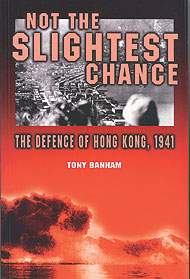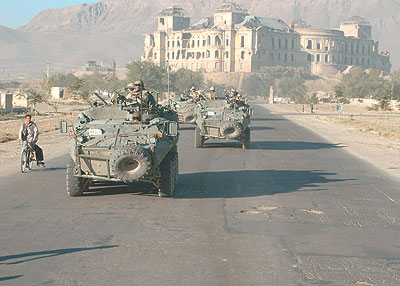 This information has been archived for reference or research purposes.
This information has been archived for reference or research purposes.
Archived Content
Information identified as archived on the Web is for reference, research or recordkeeping purposes. It has not been altered or updated after the date of archiving. Web pages that are archived on the Web are not subject to the Government of Canada Web Standards. As per the Communications Policy of the Government of Canada, you can request alternate formats on the "Contact Us" page.
Book Reviews
Not the Slightest Chance: The Defence of Hong Kong, 1941
by Tony Banham Vancouver: University of British Columbia Press.
431 pages, $29.95
(paperback)
Reviewed by Laurel Halladay
For more information on accessing this file, please visit our help page.
 Although
he would later order it held as long as possible, in the spring of
1941 Winston Churchill summed up the prospects of successfully defending
Hong Kong against a Japanese attack with the words “not the slightest
chance.” Tony Banham’s amazingly well researched book adopts
this phrase of gloomy foreshadowing as its title, and in methodical
detail relates what happened when, in the last month of 1941, the Japanese
began their assault on this British colony. In addition to being in
complete control of the air and sea, the already blooded Japanese had
numerical superiority in men and weapons, and Hong Kong fell to them
in just eighteen days.
Although
he would later order it held as long as possible, in the spring of
1941 Winston Churchill summed up the prospects of successfully defending
Hong Kong against a Japanese attack with the words “not the slightest
chance.” Tony Banham’s amazingly well researched book adopts
this phrase of gloomy foreshadowing as its title, and in methodical
detail relates what happened when, in the last month of 1941, the Japanese
began their assault on this British colony. In addition to being in
complete control of the air and sea, the already blooded Japanese had
numerical superiority in men and weapons, and Hong Kong fell to them
in just eighteen days.
Not the Slightest Chance begins with a short history of Hong Kong in the hundred years prior to this event and with an exploration of the causes leading to the inevitable war with Japan. Banham explains that the strategic goals of the Japanese from the turn of the century centred on gaining imperial power over much of Asia, and to do so they had to wrest control over the sea-lanes from oil-rich Indonesia. In 1941 and early 1942, the Japanese conducted near simultaneous attacks on “the Anglo-American naval bases” at Pearl Harbor, Manila, Singapore, Wake and Hong Kong. Banham correctly points out that no increased number of British military personnel in Hong Kong would have deterred the Japanese from achieving their strategic goal in the area. Hong Kong, because it was a key harbour, was essential to the Japanese strategy, and strengthening the garrison further would only have forced the Japanese to dedicate a larger force to capture it.
The author then looks briefly at the week preceding the battle, and the defensive measures that were in place from the outset. The main portion of the book focuses on the campaign’s six phases: the loss of the New Territories on the mainland (8-13 December), the siege of the island of Hong Kong (13-18 December), the invasion of the island (18 December), the forcing of the Wong Nai Chung Gap (19 December), pushing the line west (19-25 December) and encircling Stanley (19-26 December). Each day within these phases is broken down into an hour-by-hour summary of the action, casualties, military movements, and internal and external communication, all from the 14,000 defenders’ points of view. Each daily recounting ends with the ever-increasing Rolls of Honour that include information on the cause of death, affiliation and burial place for members of the British, Indian and Canadian regiments, the Hong Kong Volunteers, the Hong Kong Police and even some civilians. The book then proceeds to examine the last week of December 1941. Finally, Banham includes several analytical appendices that take a closer look at, among other things, the additional casualties and massacre victims and the overall losses of the British military, the civilian population, the hospitals and the Japanese. Also of great help to those doing research on this topic is a very thorough annotated bibliography that lists available films, archival documents, secondary sources and related fiction.
Although the book is meticulous in relating the details of the battle, the amount of detail makes it far too easy for the reader to get bogged down at the micro-level and forget the bigger picture. This is especially true in the period after the Japanese invade the island and the situation becomes more and more chaotic. While this level of detail is not otherwise available either in biographies or in general histories of the war, some effort to incorporate a more broadly focused main battle narrative would have been useful. The text itself is descriptive, with very little analysis. The book tends to be difficult to read in many places because of typographical and punctuation errors, a style of citation that incorporates both endnotes and parenthetical references, the fact that the present tense is used throughout, and that Banham has an awkward manner of introducing lengthy quotes. In addition, while the book is obviously written from the perspective of the island’s defenders and makes no pretense about doing more than that, further information about Japanese tactics and battle style would have gone some distance toward explaining their brutality and why the island fell by Boxing Day with fully ten percent of the defending forces being killed in action.
Having said that, there are several things Banham’s book does well. For Canadians, well-used to viewing Hong Kong as a battle conducted under incompetent British leadership, Banham offers a balanced, fair and international viewpoint that includes mentions of the Canadians, Indians, Hong Kong Volunteers and British commensurate with their participation. Likewise, although Canadian military historians have embraced the topics of Christmas celebrations during the Italian campaign and the massacre at the Abbaye Ardennes in June 1944, Christmas 1941 and the massacres at Eucliffe, Overbays and other places in Hong Kong have largely gone unexamined, and Banham has addressed that oversight.
For those who teach military history, the six phases he identifies break a complex battle into more easily digestible components and could be a great way to approach the subject in the classroom. The book includes a great many excellent maps that help the reader to understand more thoroughly the action as it proceeds.
The reader is also able to derive some tangible sense of the chaos of this battle. The author mentions, for example, that some Royal Air Force men were converted to infantry after the invasion of the island and the numerous incidences of last-ditch hand-to-hand combat. He writes of the conditions that made thinking clearly in underground plotting rooms very difficult, and of aged employees of electric power companies that were pressed into service to defend essential facilities. In addition, several events that are briefly related in Not the Slightest Chance will no doubt spark readers’ interest and encourage further research. References to the cremations of deceased Indian members of the Rajputs and the Punjabis, the friendly-fire explosion of the Jeanette lighter in the harbour, the British women who were part of the first Japanese request for surrender, and interference at the island’s military headquarters by elements of the so-called fifth column, all demand deeper exploration by military historians.
As Banham himself points out, Not the Slightest Chance does not represent a complete retelling of the costly Hong Kong battle as “the survivors still had nearly four years of war in front of them”. A companion volume covering the experiences of Hong Kong veterans over the remainder of the war would be very welcome. In the meantime, this book stands as the ultimate reference work on the defence of Hong Kong.
![]()
Laurel Halladay is a PhD candidate in the Department of History and a Research Associate at the Centre for Military and Strategic Studies at the University of Calgary.

DND Photo KA2004-R103-1593d by Corporal John Bradley
Bison armoured vehicles from the National Support Element transporting members of the 3rd Battalion, Royal 22e Régiment to Kabul airport for their return home on completion of their 6-month tour of duty in Afghanistan.






